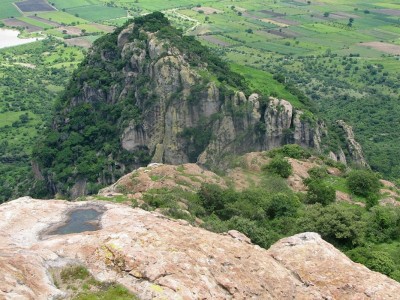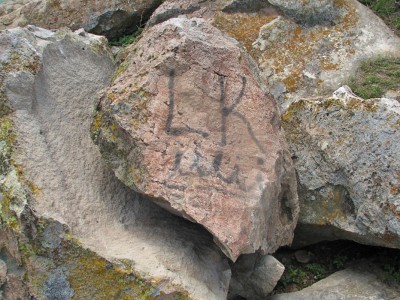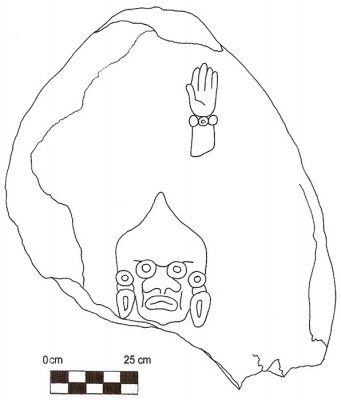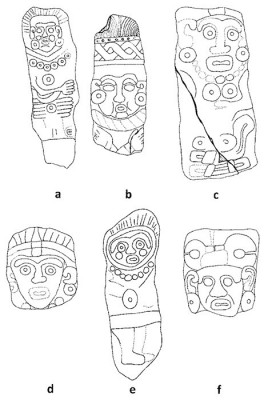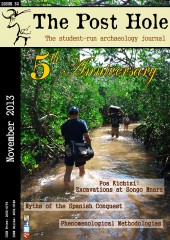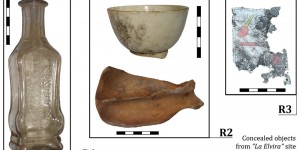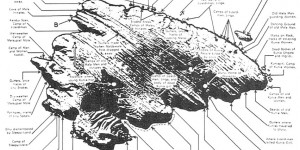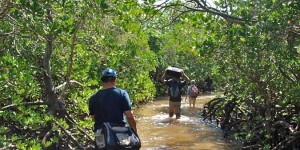The present paper re-evaluates a petroglyph, designated as Monument 10, from the archaeological site of Chalcatzingo in Morelos, Mexico. Although this rock carving’s formal properties place it within the Classic period, Monument 10 continues to be associated with the other Olmec-style monuments at the site and interpreted as a proto-rain god image. By comparing this petroglyph with the Late Classic period carvings of Los Santos Reyes Nopala in Oaxaca, however, it is proposed that the rock carving may be referencing a local ruler, possibly in the role of an ancestor.
Chalcatzingo Monument 10 was originally discovered by Gillett Griffin in 1969 and first reported by Carlo Gay (1972, 66). It consists of a petroglyph carved on the northern face of a large boulder near the summit of Cerro Chalcatzingo (Figure 1). Although earthquakes split the boulder into several sections prior to August 2005 when I began my investigations of this monument, the rock carving remains intact although highly eroded and obscured by modern graffiti (Figure 2).
The petroglyph is composed of two distinct elements (Figure 3). The main element consists of a human head portrayed in frontal view. The physiognomic features of the face include rounded eyes with large incised irises or pupils, sometimes referred to as “goggle-shaped eyes”. The face is also pictured with a broad, flaring nose and downturned mouth surrounded by thick lips. Underneath the mouth, the head terminates in a slightly pointed chin. The ears are not visible but are implied by the presence of two large circular ear ornaments, each connected to a tapered pendant or feather that hangs down to the chin. The top of the head is covered by a pointed headdress or turban, similar to those found on some of the Formative period C8 figurines from Chalcatzingo.
Above and to the right (observer’s point of view) of the head, there is a second smaller element depicting a forearm and a left hand. The hand is shown palm-outward with all fingers extended upward. The wrist is decorated with a beaded bracelet consisting of three circles. The distance between the head and hand is more or less anatomically correct suggesting that this monument does not utilize the synecdochic principle of pars pro toto so often seen in other examples of Olmec-style art (Reilly 1995). Rather, the lack of lines connecting the head and hand may be explained by the coarseness of its granodiorite medium or may be an intentional aspect of the carving related to the subject matter of the rock carving.
Previous Interpretations of Chalcatzingo Monument 10
Since the discovery and initial documentation of Monument 10, its archaeological significance and chronological position have been the subjects of on-going debate. Some researchers have advanced the argument that Monument 10 belongs to the site’s corpus of Olmec-style art. For instance, based on its physical attributes (i.e. its goggle-shaped eyes) and its apparently serpentine imagery (i.e. a headdress shaped like the tail of a rattlesnake and pendulous ear ornaments resembling fangs), Carlo Gay (1972, 66-69) contended that this rock carving depicted a Formative period precursor to the Classic and Post-Classic period rain god, glossed as “Tlaloc”. Following the work of Gay on the positioning of Chalcatzingo’s rock carvings (1972, 39; Fig. 9a), Reilly (1991, 164; Fig. 17) argued that Monument 10 formed part of a conceptual axis mundi which was used to orient the Olmec-style rock carvings on Cerro Chalcaztingo during the Middle Formative period. In so doing, he not only kept the Olmec artistic affiliation for Monument 10 but also many of its associations with water (Reilly 1991, 165).
By contrast, although David Grove and Jorge Angulo have acknowledged that the facial features of the figure in Monument 10 are typical of those found in Olmec-style art (Angulo 1987, 154; Grove and Angulo 1987, 130), their interpretations of Chalcatzingo Monument 10 have been much more nuanced. For instance, Angulo successfully demonstrated that this petroglyph does not belong to the Formative period by noting that the features of the head were carved in frontal view, a feature of Classic period low-relief carvings. Formative period sculptors, by contrast, appear to have favored the representation of human heads in profile (Coe 1965, 749). There is certainly evidence for Classic period occupations at Chalcatzingo, including two small pyramids, a ball court, and several rock paintings in the caves of Cerro Delgado (Apostolides 1987, 191-193; Martín Arana 1987, 387-394). However, Angulo has also been suspicious of interpretations of Monument 10 which emphasize its similarity to the rain god images typically associated with Classic art period (Pasztory 1974). For instance, it is not clear that the eyes are goggles at all. They may in fact be very large circular representations of eyes. The serpentine nature of the headdress is also problematic given the rock carving’s poor state of preservation.
In contrast to these questionable comparisons to Classic period rain gods, Angulo favored interpreting the figure pictured in Monument 10 through the use of ethnohistoric and ethnographic analogies as a representation of a dualistic deity such as Itzamna with sacred mountains, rainfall, thunder, and lightning (1987, 154-155). Nonetheless, he was painfully aware that there were no written or graphic references known at the time that could help in the identification of the figure and its body language. Fortunately, this situation has changed recently with the documentation of a series of relief carvings from the town of Los Santos Reyes Nopala in southern Oaxaca (Bustamante 2003). Dating to the Late Classic period (600-900 AD), these sculptures come from several neighboring archaeological sites: Cerro de la Iglesia, El Zanate, and Arroyo de Piedra. Through careful comparison, these carvings may help us to re-evaluate the features of Chalcatzingo Monument 10 and provide insight into its archaeological significance.
Chalcatzingo Monument 10 and the Late Classic Period Sculptures of Los Santos Reyes Nopala
One of the most striking features of the corpus of sculptures from Los Santos Reyes Nopala is their adherence to a set of formal aesthetic principles that are remarkably similar to those found on Chalcatzingo Monument 10 (Figure 4). Regardless of whether or not the sculptures depict a whole human being (Figure 4e), the upper torso and head (Figures 4a-c), or just a disembodied head (Figures 4d and f), they are invariably executed as low relief carvings on relatively flat slab-like stones, possibly stelae. The carvings themselves are often simple, using heavy lines to demarcate major areas of the figures such as the head and arms. Incised details and glyphs (Bustamante 2003, 84-86 and 105-106) are relatively rare, possibly due to the coarseness of gneiss as the medium used for the majority of the sculptures. Finally, all of the carvings from Nopala are also rendered in frontal view as was common practice in the Central Highlands of Mexico during the Classic period (Angulo 1987, 154).
In addition, there is a considerable degree of correspondence between the Nopala sculptures and Chalcatzingo Monument 10 in terms of the nature and arrangement of their respective iconographic elements, i.e. physiognomic features, overall posture of the figure, and elements of dress. Although some of these similarities may be due to their adherence to modes of representation common in Classic art, it is certain that they may also reflect less widely-shared sculptural practices. If this is the case, then the sculptures of Los Santos Reyes Nopala may be especially useful in gaining insights on the identity and significance of the personage portrayed in Monument 10.
I will begin by comparing the physical traits portrayed in the sculptures of Los Santos Reyes Nopala with those observed on the face rendered in Chalcatzingo Monument 10. The main figure in each of these sculptures seems to be pictured with relatively thick lips and a downturned mouth. Even though this cluster of features is often linked with Olmec-style art (Magni 2003, 177), there is no evidence to suggest that these conventions for representing the human face were necessarily absent in later traditions of Mesoamerican art. Simplistic eye-forms are also common in Nopala, probably due to the difficulty of the rock medium. Among these, large circular eyes with incised pupils or irises are fairly common (Figures 4c-e) and correspond exactly to the eye-form of the individual portrayed in Monument 10.
Another point of iconographic comparison that must be addressed is the overall posture of the figures carved in the monuments. Excluding all of the disembodied heads from the Nopala corpus, it seems quite clear that all of the remaining low relief carvings represent individuals in an upright position. Presumably, based on the position of the hand relative to the head, the same pattern holds true for the person portrayed in Chalcatzingo Monument 10. This observation brings up another problem however. As I previously noted, scholars have been repeatedly puzzled by the position of the hand in Monument 10. If one examines the full-bodied figures from Nopala, one quickly discovers that hand positioning is an important element in the representational system used at the site. Some of the sculptures show individuals with their arms crossed or flexed (Figures 4a-b); while others depict them with out-stretched arms (Bustamante 2003, 94 and 108) or holding an object (Bustamante 2003, 78). Given the complexity of the costumes shown on these personages, there may be a relationship between the meaning of the gestures and these elements of dress.
Indeed, the elements of dress which characterize the individuals depicted in these sculptures may offer the best hope for shedding light on the significance of the character portrayed in Chalcatzingo Monument 10. Simple body adornments such as jewellery may be the best place to start. Take for instance, the circular ear ornament. Originally used to chronologically tie Monument 10 to the Formative period Olmec-style rock carvings at Chalcatzingo (Gay 1972, 66), circular ear ornaments are a common feature of the Nopala sculptures (Figures 4a-d, 4f) although they are connected to visible ears and lack the pendulous elements found on the petroglyph from Chalcatzingo. Beaded bracelets and necklaces are also widespread at Nopala (Figures 4a, d-e) and appear to be signs of status or perhaps ritual costuming. Absent from these representations is any hint that the individuals portrayed in the sculptures were deities. In fact, none of the carvings of Nopala appears to be associated with any standardized set of symbols for the representation of divine beings. Rather, it appears that costume elements such as elaborate headdresses demonstrate a level of distinctness accorded to different individuals (Figure 4), possibly lords or recent ancestors, participating in ritual acts that were commemorated by the community. In the Late Classic and Epiclassic art period of El Tajín, variant hand gestures were used to communicate differences in status, such as being a noble or a captive, as well as participation in different ceremonial activities like human sacrifice (Ladrón de Guevara 2005). Given the distinctive nature of the headdress in Chalcatzingo Monument 10 and its strong resemblance to headdresses found among C8 figurines that may have been used as portraits of rulers at the site during the Middle Formative period (Grove and Gillepsie 1984, 33), a similar interpretation may be warranted for this rock carving.
Conclusions
To summarize, there is no satisfactory stylistic or contextual reason for continuing to argue that Chalcatzingo Monument 10 is a Middle Formative period, Olmec-style precursor to Classic period representations of a rain god or any other deity. Rather, comparisons with analogous Late Classic period sculptures of Los Santos Reyes Nopala in southern Oaxaca demonstrate that this petroglyph is more likely to be referencing a high ranking member of the community. The beaded bracelet and the elaborate conical headdress suggest a local ruler, perhaps using symbols of status present at Chalcatzingo since the Middle Formative period. The raised hand and out-stretched palm suggest a ritual posture, possibly indicating a ritual act or that the individual portrayed in Monument 10 has achieved a different state of being such as that of an ancestor. Until the variant hand gestures observed at Chalcatzingo and Nopala can be properly contextualized and our understanding of their iconography more fully developed however, these alternative interpretations must remain speculative.
Acknowledgments
I am grateful to the Consejo de Arqueología of the Insistuto Nacional de Antropología e Historia for providing me the opportunity to conduct my investigations at Chalcatzingo in August 2005 (INAH Permit No. P.A. 42/05). I would also like to thank Mario Córdova Tello and the staff of the INAH center of Morelos for facilitating my research. Funding was provided from a graduate student research grant from the Anthropology Department at Brandeis University.
Bibliography
- Angulo, V. J. (1987). ‘The Chalcatzingo Reliefs: An Iconographic Analysis’, in D.C. Grove (Ed). Ancient Chalcatzingo. Austin: University of Texas Press. 132-158
- Apostolides, A. (1987). ‘Chalcatzingo Painted Art’ in D.C. Grove (Ed). Ancient Chalcatzingo. Austin: University of Texas Press. 171-199
- Bustamante, L.A. (2003). Análisis Iconográfico de las Piedras Grabadas de Los Santos Reyes Nopala, Juquila, Oaxaca. Tesis de Licenciada. Mexico City: Escuela Nacional de Antropología e Historia
- Coe, M.D. (1965). ‘The Olmec Style and Its Distribution’ in G.R. Willey (Ed). Handbook of Middle American Indians Volume 3 - Archaeology of Southern Mesoamerica, Part 2. Austin: University of Texas Press. 739-775
- Gay, C. (1972). Chalcacingo. Portland, Oregon: Interntational Scholarly Book Services
- Grove, D.C. and Angulo, V. J. (1987). ‘A Catalog and Description of Chalcatzingo’s Monuments’ in D.C. Grove (Ed). Ancient Chalcatzingo. Austin: University of Texas Press. 114-131
- Grove, D.C. and Gillespie, S.D. (1984). ‘Chalcatzingo’s Portrait Figurines and the Cult of the Ruler’. Archaeology. 37(4) 27-33
- Ladrón de Guevara, S. (2005). ‘Lenguaje corporal en Tajín’. Arqueología Mexicana. 12(71). 44-47
- Magni, C. (2003). Les Olmèques: Des Origines au Mythe. Paris: Éditions du Seuil
- Martín Arana, R. (1987). ‘Classic and Postclassic Chalcatzingo’ in D.C. Grove (Ed). Ancient Chalcatzingo. Austin: University of Texas Press. 387-399
- Pasztory, E. (1974). ‘The Iconography of the Teotihuacan Tlaloc’. Studies in Pre-Columbian Art and Archaeology, No. 15. Washington D.C.: Dumbarton Oaks Research Library and Collection
- Reilly, F. K. III (1991). ‘Olmec Iconographic Influences on the Symbols of Maya Rulership: An Examination of Possible Sources’ in V.M. Fields (Ed). Sixth Palenque Round Table, 1986. Norman: University of Oklahoma Press. 151-166
- Reilly, F. K. III (1995). ‘Art, Ritual, and Rulership in the Olmec World’ in The Olmec World: Ritual and Rulership. Princeton: The Art Museum, Princeton University. 27-46


